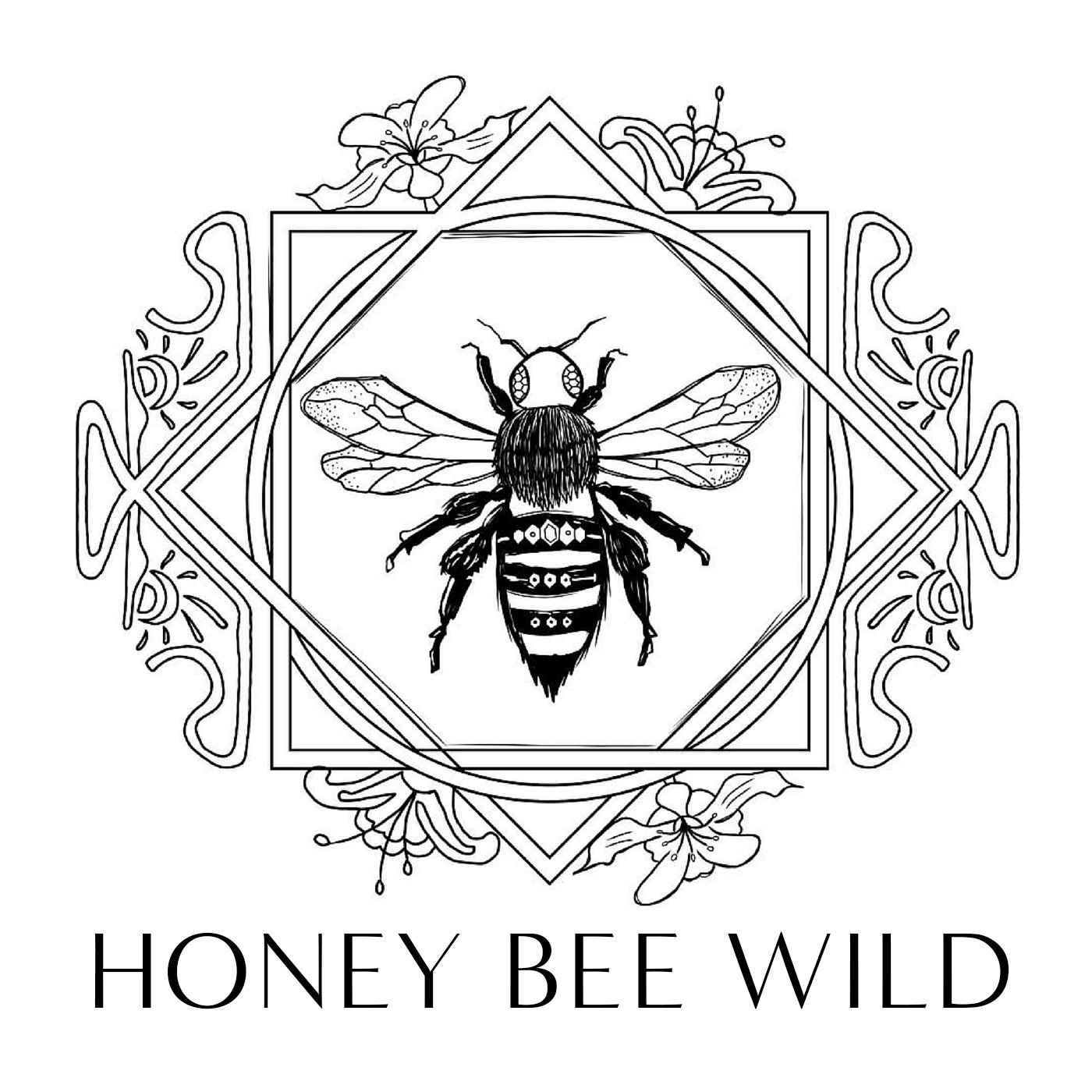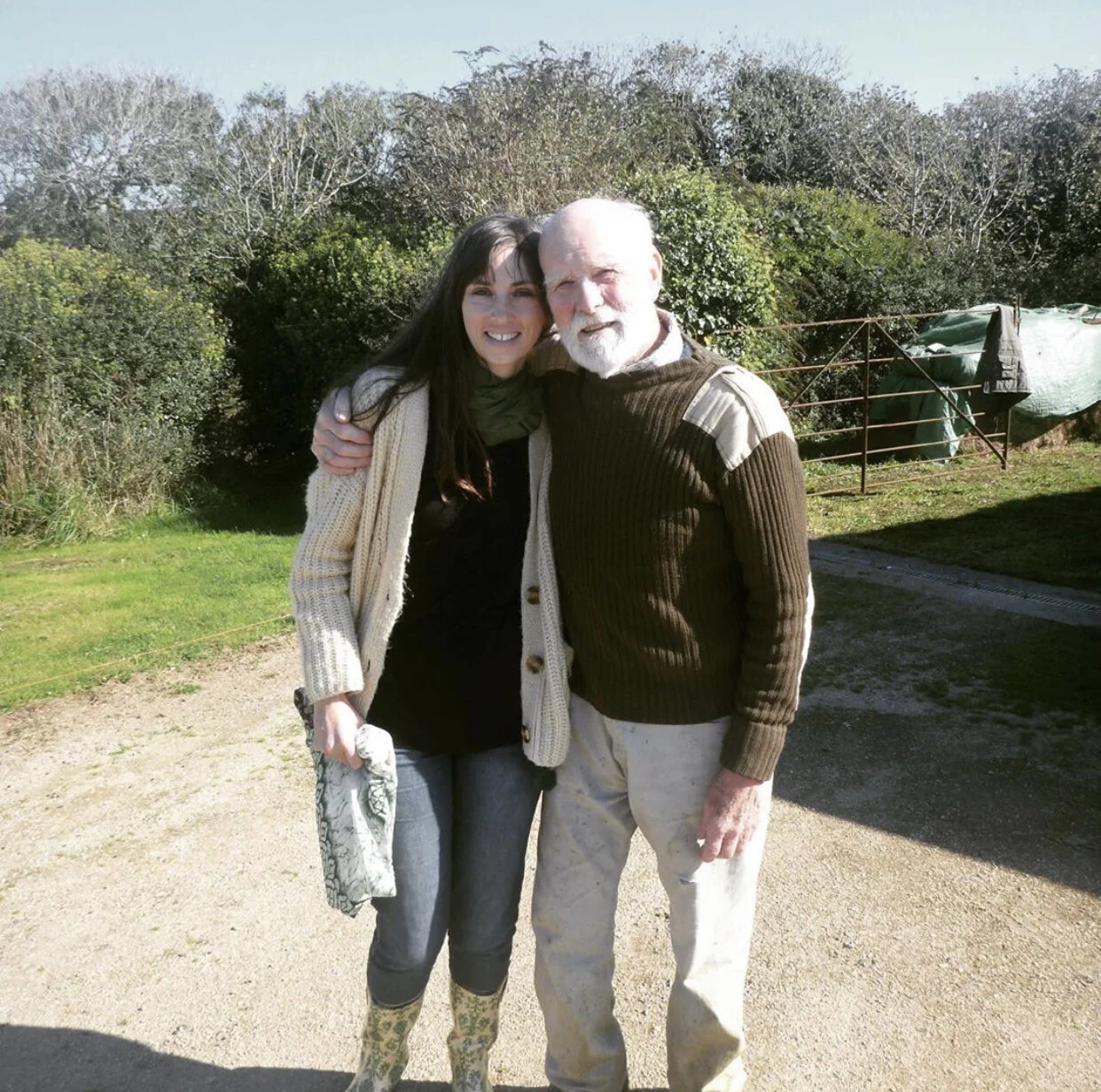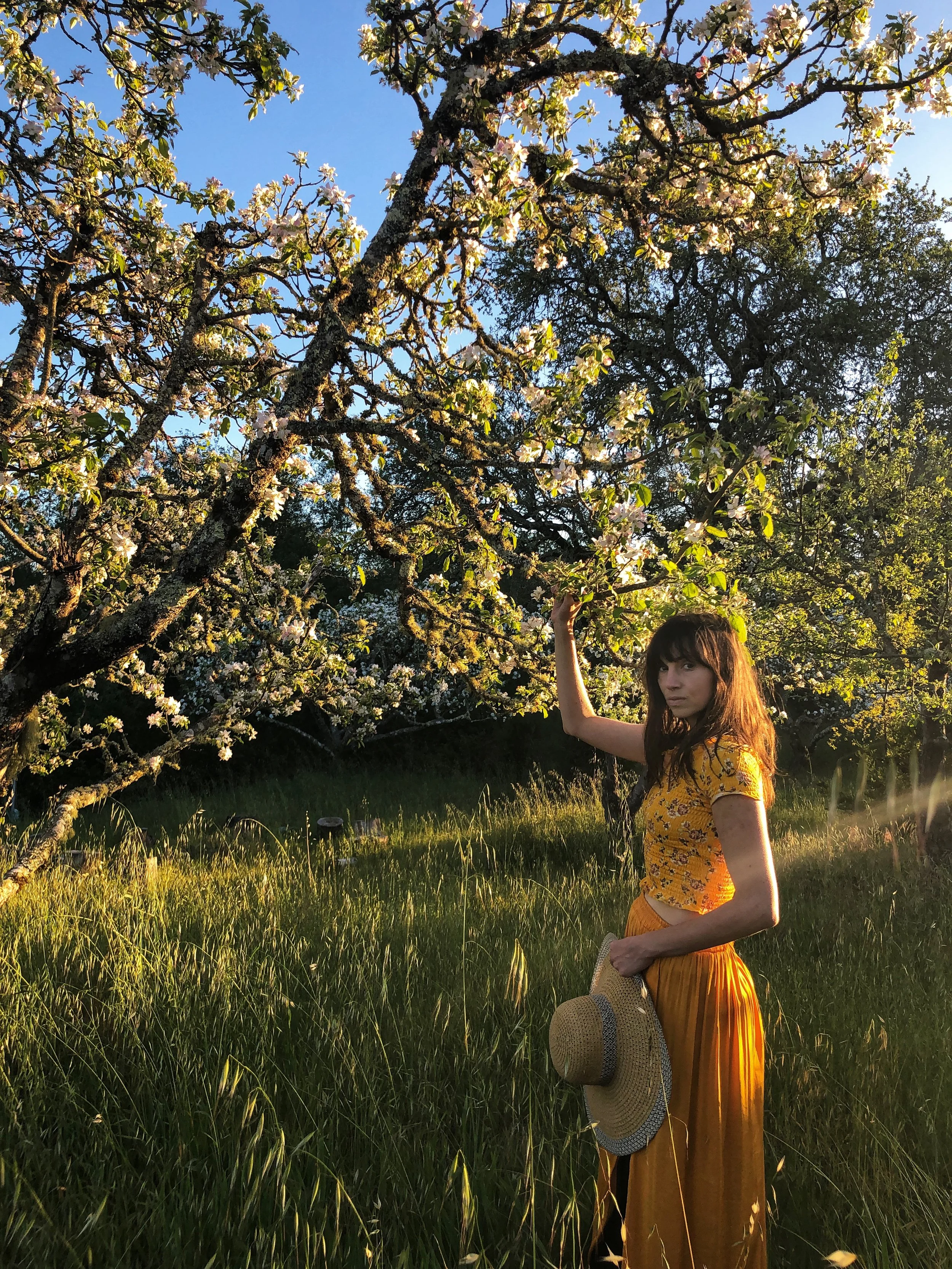She Survived
Once, I drove through the narrow country roads of west Cornwall to find a sacred well. It was autumn and the sea looked Caribbean turquoise. The map wasn’t very good, but my friend and I found the well, partially overgrown with ivy, but not forgotten. One of the old places, where women’s water wisdom once offered healing and insight. A nearly obscured heritage. ⠀
Once, I drove through the narrow country roads of west Cornwall to find a sacred well. It was autumn and the sea looked Caribbean turquoise. The map wasn’t very good, but my friend and I found the well, partially overgrown with ivy, but not forgotten. One of the old places, where women’s water wisdom once offered healing and insight. A nearly obscured heritage. ⠀
The land owner, Trevor, met us at the gate, literal pitchfork in hand. He was happy to see us. He had learned a thing or two since he took over care of the property. He spoke to us of moon pools and the goddess Diana. He said Druids and shamans and all manner of pagan folk had visited the well over the years. It’s important, he said, because a well like that must be tended. He sent us on our way, we made our prayers, left our offerings and wondered at the lost ancient ways weeping through our veins.⠀
Then Trevor asked us in for a sherry. You never refuse a sherry from a white bearded farmer guarding a sacred well. There are rules. ⠀
Inside there was a spinning wheel and herbs. There were stacks and stacks of books. There was the love of a wife long past. Trevor handed us sherry in tiny glasses as said, “You know, this home used to be the home of a famous herbalist. Jessica was her name. She lived here in the 1600s. She knew how to make the secret preparations to call down the bees.”⠀
There it is. Not a mention of bees from my lips and here, this agnostic, curious farmer is telling me about the bees. How she could get them to swarm into the house. How she would heal the people with their remedies. She may have survived despite her arts, when so many women of her time perished. She who lived with these walls, and drank from the well, and walked in the ways of women’s mysteries. She who lived in a time when herbalist was synonymous with witch. Her wisdom meant death.⠀
Dear you, who tends the garden and sings to the bees in 2019, know that the thread survived in you. Remember that no matter how hard the men of the church tried to take women’s spirituality away from them, it survived, because it’s in you now.
They took the power of your weaving chants and called you an enchantress. For this you burned. They said no one could chant words of power but men. They took your healing arts and called you a witch. For this you drowned. No one could heal, save the grace of God and his doctors. They took your words and turned them against you. For this you were silenced.
But you survived, because the songs you wove were strong and made of the earth herself. You survived because you felt the warp and weft of life and death move through your own lunar tides, and you came to know cycles. You survived because you knew that someday you would be borne into the rich blood of your distant granddaughter and she would learn the secret ways to make preparations to call down the bees.
Apple: Fruit of the Otherworld
It’s apple season here in Sebastopol. I grew up in a land of cedars and pine, but moved to the soft, apple hills of this small town, which used to be the Gravenstein capital of the world. Some of the old orchards have resisted the encroaching vineyards and every spring they are ablaze with white blossoms and memories of Avalon.
Apple
æppel • aball • malum
Main Pollinators:
Honey bees, mason bees (but there are many more!)
It’s apple season here in Sebastopol. I grew up in a land of cedars and pine, but moved to the soft, apple hills of this small town, which used to be the Gravenstein capital of the world. Some of the old orchards have resisted the encroaching vineyards and every spring they are ablaze with white blossoms and memories of Avalon. This time of year the apples fall faster than we can pick them. Yesterday I saw two white-spotted fauns in the middle of an orchard enjoying the free harvest while mama looked on. Apple harvest is always a good time of year. It means love it in the air. Always has, always will.
The apple we know today is originally from Central Asia, but has been cultivated in Europe and Asia for thousands of years. In Ireland and Britain, there is a smaller, native apple known as crab apple, or to the Celts, wild apple. In Scotland, Wales and Ireland, you can still find windblown, twisted apple trees with ribbons and cloth tied to the branches . These trees are called Clootie trees and are a form of prayer tree. Two of the most common Clootie trees are Hawthorne and Apple, both associated with love and the Otherworld.
Apples are Faye food. Forbidden fruit. Fruit of the dead. Love fruit. Witches fruit. They hang heavy off the many-branched tree of folklore. After all, wasn’t it our courageous Eve who first tasted their promise of Gnosis (although let’s be honest, her apple was most likely a pomegranate).
It was apple, gifted by the Goddess Iðunn who gave the Norse gods eternal youth. In Ancient Greece, apple was the fruit most beloved to Hera, Athena and above all, Aphrodite, goddess of Love. It is not surprise that Apple was associated with youthfulness, love and fertility. It’s health benefits are many and varied, but they are particularly known to prolong life through aiding in digestion, liver function as well being a good source for vitamin C, B6, and potassium.
My favorite apple myths spring from Celtic mythology. In Irish folklore, the Wild Apple was a sacred chieftain tree, and to cut it down without permission engendered a hefty penalty. It was often associated with the Otherworld and apples were commonly found buried with the dead. The Otherworld however, is more than the place of the dead, it also represents the land of the Faye folk, who were said to live in the hollow hills, the trees and in the sacred isles beyond the ninth wave.
In one Irish myth, a Sidhe, or fey maiden falls in love with a mortal and sings her love to him. She is chased off by his father’s men, but before she departs, she throws him an apple. The apple is fairy food and is ever-renewing. The fruit alone sustains the mortal for a year, until she returns on her crystal ship and they sail to the Otherworld together.
In another Irish myth, through trickery, two lovers are kept apart and die. On the grave of the maiden an apple tree grows. On her lover’s grave, many miles away, a Yew tree sprouts. The trees grow and bend longingly toward on another for seven year. Then the trees are cut down by bards and all the stories of love and romance that ever fell from lips were carved upon wooden tablets made from the trees. Eventually these tablets found their way to the hands of the high king of Tara. When the love tablets were side by side, they sprang into each others arms, becoming as deeply entwined as the branches of an ancient tree.
I wrote a song once called Apple Tree, about loving and letting go, inspired by the Celtic lore. You can listen to it here.
In Arthurian myth, the Isle of Apples is another name for Avalon: the land lost in the mists. When Arthur is mortally wounded, his half-Faye sister, Morgan le Fey, ushers him on her boat to the Isle of Apples, a place of eternal summer, where Arthur sleeps until it is time for him to wake and return to the world of man. Today that isle is associated with Glastonbury Tor in England, where the veil between the world is quite thin. This photo is from the apple orchard on the side of that famous fairy mount.
From stories such as these, and many others, a myriad of folk traditions have arisen. In Britain and Ireland, to toss an apple to someone is a declaration of love. Similarly, to cut an apple crosswise, revealing the star, and then share it with another, is also an act of love. At harvest faire, around the the time of Samhain, young women would bob for apples. Once an apple was caught, the girl would peel the apple in one long ribbon and then toss the peel over her shoulder. The peels were then inspected to see if they made a letter, which was believed to be the first letter of the girl’s future husband.
Beyond romance, apples were also commonly associated with divination and magical folk. Druid’s divining rods were carved from Apple. Merlin himself was thought to practice his arts in a sacred apple grove. The trees were so important, that a long standing tradition of honoring them at midwinter arose. This tradition involved heading to the orchard on midwinter eve or Christmas eve. A tree was selected to represent the commonwealth of Apple trees and was then saluted and blessed with cider, cakes, song and poetry. This tradition is called Wassailing and is still practiced to this day.
Some of my favorite traditions that you can incorporate into your autumn harvest are:
Making apple cider vinegar and sprinkling it on an apple tree at midwinter
Baking apple crisps for your loved one, infused with cinnamon and clove
Collecting dried apple seeds in a small sachet and sleeping with them under your pillow for support in dreams of the otherworld
Leaving apple offering to the fey folks when the veil is thin at times such as Autumn equinox and All Hallows Eve.
Pelting your crush with apples, just to be sure they know you like them.
Leaving apples or apple seeds on your ancestral altar to honor the spirits who have journeyed to the underworld.
Happy Harvest!
Lavender: Giddy Calm
I will never forget the way it hit me. Like a physical bath of scent. We arrived in Sainte-Croix-à-Lauze just as dusk descended. The crickets were declaring the glories of summer, while fireflies emerged to secret the sun away into the night. It was heaven. I got high.
Lavender⠀
Lavande • Lavendre• Lavandula⠀
⠀
Pollinators: ⠀
Honey bee, bumble bee, digger bee, carpenter bee, leafcutter bee⠀
⠀
Medicinal parts used: ⠀
Flowers⠀
⠀
Preparations:⠀
Teas, tinctures, essential oil, spice for cooking/baking, hydrosols, lotions and ointments, ⠀
I will never forget the way it hit me. Like a physical bath of scent. We arrived in Sainte-Croix-à-Lauze just as dusk descended. The crickets were declaring the glories of summer, while fireflies emerged to secret the sun away into the night. It was heaven. I got high. Quite literally, the scent of lavender so engulfed me, that I sort of lost it for a bit. I was a mess of giggles and wonder. A friend and I have meandered our way through Provence to the tiniest town in the Hautes-Alpes. There wasn’t even a cafe. It was just an old, stoney town with one central spring, and on all sides, Lavender. Fields and fields and fields of the heaviest, sweetest scent I had ever experienced.
My mother grows lavender. Heaps of it. It lines the apiary and turns dry and grey-violet each summer. It’s absolutely lovely. I cut bunches of it for making oils, sachets and wall hangings. This was NOT that lavender. This was otherworldly. I thought I knew lavender. This was something else. This gave me superpowers. This was a soup of scent. This was the the loosening of my hair. This was barefoot crush. This was an intravenous anti-anxiety drip, except with breath. Imagine breathing a sort of liquid, giddy calm. How can you be giddy and calm? Go to Provence in July in the evening.
Our AirBnB host was a tall, linen-wearing woman with a long sliver braid looped over her shoulder. She was celebrating a birthday in the neighbor’s yard with a weaver and a beekeeper when we arrived. They invited me down because, well…beekeeper. By the next morning my doorstep was filled with Oak honey and homemade rosewater. I knew, in that moment that I was about to fall in love. Not with the beekeeper, but someone. (I did by the way, shortly after, although it swiftly ended in heartbreak). I still eat a bit of that Oak honey every day. I still believe it will lead me to love.
I had just finished teaching Apis Sophia Exstasis, a women’s retreat in Aquitaine, and I was exhausted. My friend Nani and I drove 10 hours across France to hide away in a stone cottage and inhale lavender. She made me salmon that first night, but the kitchen was lacking basics and the nearest grocery story was a hour away. We made do with butter, salmon and red wine. It turns our a red wine butter sauce of salmon is quite tasty, and to this day, whenever either of us is in a bit of a conundrum we tell each other to just “Pour some red wine on it.” Can’t figure out how to keep your houseplant alive? Pour some red wine on it. Feeling confused about some nasty paperwork? Pour some red wine on it. You get the gist.
On our last night, we shared a glass (we are big lightweights, so one was clearly enough) and went for a midnight stroll through lavender fields, picking a stalk here and a stalk there, absolutely certain all wrath and furry were about to descend on us for our shitty tourist trespassing. Then we did the unthinkable (and by unthinkable, I mean I literally didn’t even think about it - whoops), and brought those stalks home in our suitcases. I know, we are the worst. No that lavender is infused into an oil that I use on my skin daily for nourishment and anxiety relief.
Used by Egyptians in the mummification process and cultivated for its oil in ancient Arabia, lavender has been a sacred and beloved herb in healing, cosmetic and culinary arts for millennia.⠀
⠀
It is an herb used for calming the nervous system, treating wounds, easing headaches, improve sleep and offers a general feeling of wellbeing.⠀
⠀
It was spikenard, a form of lavender, that Mary Magdalene used to anoint Jesus’ feet. ⠀
Lavender honey is very light, herbaceous, floral and pairs well with soft cheeses, figs, and my favorite: biscuits and Devonshire cream.
⠀
Here are some of my favorite ways to love lavender:⠀
⠀
* I use drops of lavender essential oil in my humidifier at night. ⠀
* I gather it every midsummer for making lavender infused oils (not EO). Oiling the skin is of a daily ritual for me, as I have every sensitive skin and live in a dry place. Lavender oil soothes mind and body.⠀
* I make lavender infused chocolate truffles which I used to take to Burning Man to feed all my friends.⠀
* I put it in sachets for dreams when I am needing lightness⠀
* I sprinkle it into almond honey cakes, which make great ritual offerings.⠀
* I hang a bundle over my bed ⠀
* As a hydrosol, it never leaves my side⠀
* I mix it in a calming tea blend, often with nettles, chamomile, and rose. ⠀
* I watch the bees dance through it.




















